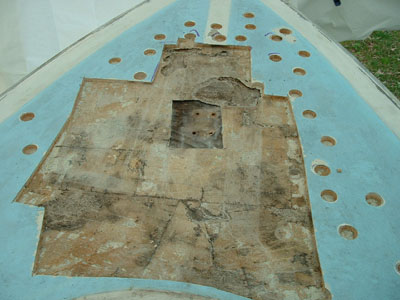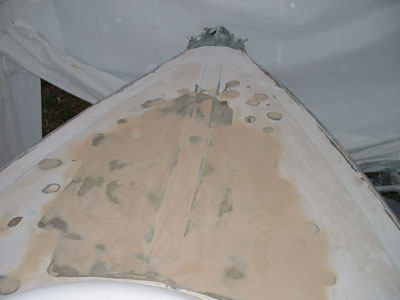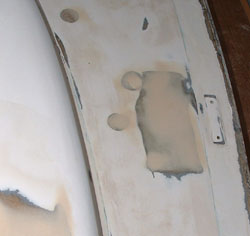|
|||
 |
The port side seats had
been cracked and water had rotted the cored seats completely. It's
not clear how they got cracked, it looked like something very heavy had
been dropped on them.
The seats seemed like a safe place to start learning how to recore and relaminate. They would usually be covered with cushions and any problems could be covered up. |
||
|
On the recommendation of several other Cape Dory owners, I used end-grain cedar to replace the rotten balsa core. The open area was some damage beyond the cored area. |
After multiple layers of fiberglass cloth, the core is ready for fairing. The original top layer of glass was not salvageable. |
||
|
After some fairing filler and lots more sanding, port side seats (there is an equal amount of damage further aft...) are quite smooth and solid.
|
|
||
| The cabin top had core
damage from leaky jib tracks. The starboard side looked equally
bad on the surface (extensive gelcoat cracking and corrosion on the
screws from the inside). After cutting off the top layer of glass
on the starboard side, all I found was perfectly dry, solid-as-
the-day-it-was-laid core!
With so much core work ahead, it was a little discouraging to be making work for myself. At least I know that the core is now solid on both sides. |
|
||
|
|
The cockpit sole also
needed lots of attention. The blue non-skid (just paint with grit
as original) was removed to show the full extent of the damage.
The recoring process was getting to be very straight forward at this point. The only catch was that I kept stepping where I just worked! The cockpit is not very big. |
||
| Just as I was starting to
feel like I was making headway, I drilled a few test holes on the poop
(stern) deck. On the surface it looked great. The bow
was clearly a disaster zone, but the stern looked so smooth and
solid.
Wrong. Total black mush. The poop deck core was 75% gone! The cleats, outboard bracket and mainsheet blocks had clearly never been rebedded. I made a major mistake by not coming up with some way to support the very flimsy bottom layer of glass. Access to this area from underneath is far worse than an MRI machine... The weights to hold down the new core -- also pushed down the weak deck.
|
|
||
After lots of extra work and fairing, I am finally
pretty happy with the new curve of the deck. |
With the new taffrail in place and some of
the hardware replaced. 
|
||








